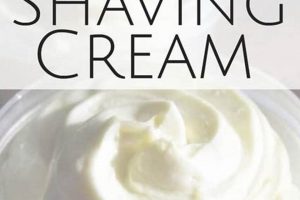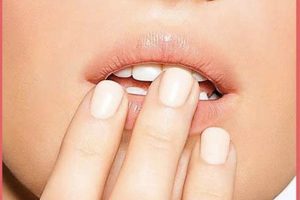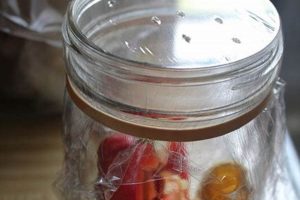A homemade solution formulated for the purpose of sanitizing and maintaining makeup application tools. This type of cleaning agent is typically created using common household ingredients to remove makeup residue, oils, and bacteria from brush bristles. Examples may include mixtures of gentle soap, oil, and water or variations incorporating vinegar or alcohol for enhanced disinfection.
The creation and utilization of such solutions offers several advantages, including cost-effectiveness and control over ingredients, which can be particularly beneficial for individuals with sensitivities to commercial products. Historically, makeup artists and enthusiasts alike have sought methods to extend the lifespan of their tools and ensure hygienic application practices, leading to the development and sharing of numerous recipes and techniques.
The following sections will explore readily available ingredients suitable for creating these homemade cleansers, effective mixing and application techniques, and crucial considerations for proper brush care and maintenance following the cleaning process.
Essential Considerations for Homemade Cosmetic Brush Sanitation
The following are crucial guidelines for effective and safe implementation of a homemade brush cleansing regimen. Adhering to these recommendations will ensure optimal hygiene and prolong the lifespan of valuable cosmetic tools.
Tip 1: Ingredient Selection is Paramount: Exercise diligence in choosing components. Mild, pH-balanced soaps are preferable to harsh detergents that can damage delicate bristles. Consider incorporating natural oils, such as olive or coconut oil, to condition and prevent brittleness.
Tip 2: Dilution is Critical: Avoid using concentrated solutions directly. Always dilute the chosen cleansing agent with water to minimize potential damage to brush fibers and prevent residue buildup.
Tip 3: Technique Matters: When cleaning, gently swirl the brush across a textured surface, such as a silicone mat, to dislodge embedded makeup. Avoid excessive pressure or scrubbing, which can cause bristle breakage.
Tip 4: Rinsing Must Be Thorough: Ensure complete removal of all cleaning solution from the bristles. Residual soap can attract dirt and promote bacterial growth.
Tip 5: Proper Drying is Non-Negotiable: Allow brushes to air dry horizontally or slightly downward to prevent water from seeping into the ferrule, which can loosen the glue and cause shedding. Avoid direct sunlight or heat, which can damage the bristles.
Tip 6: Regular Cleaning is Key: Implement a consistent cleaning schedule based on usage frequency. Daily use warrants weekly cleaning, while less frequent use can be addressed bi-weekly or monthly.
Tip 7: Disinfection Protocols: For enhanced sanitization, especially after using brushes on individuals other than oneself, consider incorporating a small amount of isopropyl alcohol (70% concentration) into the cleaning solution. However, exercise caution, as excessive alcohol can dry out the bristles.
Consistent implementation of these strategies promotes hygiene, preserves the integrity of the makeup application tools, and ultimately contributes to improved cosmetic application outcomes.
The concluding segment will provide insights regarding the appropriate storage of cosmetic brushes and address potential challenges associated with maintaining these essential implements.
1. Ingredient selection
The efficacy and safety of any homemade cosmetic brush cleaning solution are directly and fundamentally tied to the meticulous selection of its constituent ingredients. This is not merely a matter of preference; the specific substances employed directly influence the solution’s ability to effectively remove makeup residue, oils, and bacteria without compromising the integrity of the brush bristles. The choice of ingredients determines the cleaning power, the potential for allergic reactions, and the overall lifespan of the cosmetic brushes.
For instance, opting for a harsh detergent, while seemingly effective at removing stubborn makeup, can strip the bristles of their natural oils, leading to dryness, brittleness, and eventual shedding. Conversely, selecting a mild, pH-balanced soap, such as castile soap, provides a gentle yet effective cleaning action without causing damage. Similarly, incorporating a small amount of conditioning oil, such as olive or coconut oil, can help maintain the bristles’ suppleness and prevent them from becoming brittle. Real-life examples abound where individuals have damaged expensive makeup brushes by using inappropriate cleaning solutions, highlighting the practical significance of understanding the impact of ingredient selection. Another critical consideration is the potential for allergic reactions. Individuals with sensitive skin may react adversely to certain ingredients, such as fragrances or dyes, underscoring the need to carefully scrutinize ingredient lists and opt for hypoallergenic options.
In summary, the connection between ingredient selection and homemade brush cleaning solutions is one of direct cause and effect. The ingredients chosen determine the solution’s cleaning efficacy, its potential for causing damage or allergic reactions, and its overall impact on brush longevity. Therefore, a thorough understanding of the properties of different ingredients and their potential effects is essential for creating a safe and effective cleaning solution.
2. Dilution ratios
The efficacy and safety of a homemade cosmetic brush cleaner are intrinsically linked to the careful consideration of dilution ratios. These ratios, representing the proportion of cleaning agent to water, directly influence the solution’s cleaning power and its potential to damage delicate brush fibers. An improperly diluted solution can prove either ineffective, failing to adequately sanitize the brushes, or overly aggressive, leading to bristle degradation and reduced brush lifespan. For instance, a concentrated solution of dish soap, often cited in unregulated “recipes,” can strip natural oils from brush hairs, causing them to become brittle and prone to breakage. Conversely, a solution that is too diluted may not sufficiently remove embedded makeup residue and bacterial buildup, rendering the cleaning process largely ineffective and potentially promoting unsanitary conditions.
The practical application of appropriate dilution ratios necessitates a clear understanding of the cleaning agent’s concentration and the sensitivity of the brush materials. Natural hair brushes, such as those made from goat or sable hair, typically require more gentle cleaning solutions and higher dilution ratios compared to synthetic brushes. A common approach involves starting with a highly diluted solution and gradually increasing the concentration until the desired cleaning effect is achieved without causing damage. Fur
thermore, the frequency of brush cleaning also factors into the ideal dilution ratio; brushes cleaned more frequently may require a less concentrated solution than those cleaned less often. Precise recommendations vary depending on the specific ingredients used, but a general guideline is to begin with a ratio of one part cleaning agent to three parts water and adjust accordingly based on observation and experience.
In summary, the relationship between dilution ratios and the effectiveness of homemade brush cleaners is direct and consequential. Overly concentrated solutions risk damaging the brushes, while insufficient dilution compromises cleaning efficacy. Careful attention to these ratios, coupled with an understanding of brush material sensitivities and cleaning frequency, is paramount for achieving optimal results and maximizing the lifespan of cosmetic application tools. Neglecting this aspect can lead to both unsanitary conditions and premature brush degradation, undermining the intended benefits of a homemade cleaning regimen.
3. Cleaning technique
The method employed for cleaning cosmetic brushes directly impacts the effectiveness of any cleaning solution, including those prepared domestically. Proper technique ensures thorough removal of makeup residue and minimizes the risk of damage to the brush fibers, thereby extending the lifespan of the tools and promoting hygienic application.
- Swirling Motion and Surface Texture
The application of a swirling motion, rather than a direct scrubbing action, is crucial. This technique facilitates the lifting and removal of makeup particles lodged within the bristles without causing excessive friction or breakage. The incorporation of a textured surface, such as a silicone cleaning mat, further enhances this process by providing additional agitation to dislodge stubborn residue. For example, gently swirling a foundation brush on a textured surface with a mild cleanser aids in removing the typically dense and adherent product without compromising the brush’s structural integrity.
- Orientation and Water Flow
Maintaining a downward bristle orientation during the cleaning process is vital to prevent water from entering the ferrule, the metal part that secures the bristles to the handle. Water accumulation in this area can loosen the glue, leading to shedding and premature brush failure. Moreover, directing the water flow from the base of the bristles downwards helps to flush out makeup residue effectively. A real-world application of this principle involves holding the brush at a slight angle under running water, ensuring that the water flows away from the ferrule and carries the dislodged makeup downwards.
- Pressure Modulation
Applying appropriate pressure is essential for effective cleaning without damaging the brush. Excessive pressure can splay the bristles, causing them to lose their shape and effectiveness. A light, controlled touch is sufficient to agitate the bristles and remove residue, particularly when combined with the correct swirling motion and surface texture. An example would be gently massaging the brush head with a small amount of cleaning solution, avoiding forceful squeezing or pulling.
- Rinsing Thoroughness
Complete removal of all cleaning solution from the bristles is paramount. Residual cleanser can attract dirt and promote bacterial growth, negating the benefits of the cleaning process. Thorough rinsing under running water, until the water runs clear, ensures that no cleaning solution remains within the brush. Failing to properly rinse can result in product build-up that affects makeup application and potentially irritates the skin.
The selection and execution of a suitable cleaning technique are indispensable for the successful implementation of any brush cleaning regimen. The combination of a swirling motion on a textured surface, a downward bristle orientation, modulated pressure, and thorough rinsing contributes to effective residue removal, extended brush lifespan, and optimal hygiene. The alternative, a haphazard cleaning approach, can lead to ineffective cleaning, brush damage, and potentially, skin irritation.
4. Rinsing efficacy
Rinsing efficacy represents a critical, often underestimated, stage in the practice of using homemade cleansing agents on cosmetic brushes. The thoroughness with which a brush is rinsed after the application of a domestic cleansing solution directly influences the hygiene, longevity, and performance of the brush. Inadequate rinsing negates the benefits of the cleaning process, potentially leading to adverse outcomes.
- Residue Accumulation
Insufficient rinsing leaves residual cleaning agent within the brush bristles. This residue attracts dirt and makeup, creating a breeding ground for bacteria. For instance, soap residue left in a foundation brush can cause product to apply unevenly and may lead to skin irritation or breakouts. Complete removal of the cleaning agent is therefore essential.
- Bristle Degradation
Certain ingredients commonly found in homemade cleansers, such as harsh soaps or detergents, can damage brush fibers if not thoroughly rinsed. Over time, residual cleaning agent can dry out bristles, causing them to become brittle and prone to breakage. This effect is particularly pronounced with natural hair brushes. Consistent, thorough rinsing mitigates this risk.
- Product Interference
Residual cleaning agent can interfere with the application of makeup. The presence of even trace amounts of soap or oil can alter the consistency and pigmentation of cosmetic products, resulting in streaky, uneven, or otherwise undesirable application. Effective rinsing ensures that the brush is free from contaminants that could affect product performance.
- Water Quality Impact
The type and temperature of water used during rinsing also contributes to efficacy. Lukewarm water generally aids in dissolving and removing cleaning agents more effectively than cold water. Moreover, the mineral content of the water can influence rinsing efficiency. Hard water, for instance, may leave a residue of its own, potentially counteracting the benefits of the cleaning process. Therefore, consideration should be given to the quality and temperature of the rinse water.
In conclusion, achieving optimal rinsing efficacy is indispensable to the successful application of homemade brush cleaning solutions. Thorough rinsing prevents residue accumulation, minimizes bristle degradation, avoids product interference, and necessitates consideration of water quality. The neglect of this crucial step can undermine the entire cleaning process, rendering the homemade solution ineffective and potentially detrimental to both the brushes and the user.
5. Drying protocol
The drying protocol represents an indispensable element in the overall process of utilizing homemade cleansing solutions for cosmetic brushes. Following thorough cleaning, the method by which brushes are dried significantly influences their longevity, structural integrity, and hygienic state. An inade
quate drying process negates many of the benefits derived from employing even the most effective cleaning solution.
One critical aspect of the drying protocol involves brush orientation. Brushes should invariably be dried horizontally or with the bristles pointing slightly downward. This orientation prevents water from seeping into the ferrule, the metal component that secures the bristles to the handle. Water accumulation within the ferrule can loosen the adhesive, leading to bristle shedding and ultimately, brush failure. Real-world examples are abundant; professional makeup artists routinely emphasize the importance of proper drying to maintain the investment in their tools. Furthermore, the drying environment is a crucial consideration. Brushes should be dried in a well-ventilated area, away from direct sunlight or excessive heat. Direct sunlight can damage the bristles, causing them to become brittle and prone to breakage. Similarly, excessive heat can distort the shape of the bristles and compromise their performance. A practical illustration of this principle involves air-drying brushes on a clean towel in a cool, shaded location.
The time required for complete drying is another essential factor. Rushing the drying process can lead to the growth of mold and bacteria within the bristles, negating the cleaning efforts. Complete drying ensures that all moisture is eliminated, preventing the proliferation of microorganisms. In summary, a meticulously executed drying protocol is paramount to realizing the full benefits of utilizing do-it-yourself brush cleansing solutions. Proper orientation, appropriate environment, and sufficient drying time are critical to preserving brush integrity, maintaining hygiene, and ensuring optimal cosmetic application. Deviations from these protocols can result in premature brush degradation and potentially, unsanitary conditions.
6. Sanitization frequency
The regularity with which cosmetic brushes undergo sanitation, especially when utilizing homemade cleansing solutions, significantly impacts both the hygiene and longevity of these tools. Establishing and adhering to an appropriate sanitization schedule is crucial for mitigating the risks associated with microbial contamination and maintaining optimal brush performance.
- Daily Use Brushes
Brushes employed for daily application of liquid or cream-based products, such as foundation or concealer, necessitate more frequent sanitation. These products create a moist environment conducive to bacterial proliferation. A cleaning schedule of at least once weekly, or more frequently depending on individual factors, is advisable to prevent the buildup of harmful microorganisms. Failure to adhere to this frequency can result in skin irritation or breakouts due to bacterial transfer.
- Infrequent Use Brushes
Brushes used sporadically, particularly those intended for powder-based products, can tolerate a less frequent sanitization schedule. However, even brushes used solely for powders accumulate oils, dead skin cells, and environmental contaminants. A cleaning interval of every two to four weeks is generally sufficient for brushes used infrequently. Neglecting sanitation for extended periods can lead to product build-up and reduced brush performance.
- Sharing of Brushes
The practice of sharing cosmetic brushes, regardless of the type of product applied, necessitates immediate sanitization after each use. Sharing brushes introduces the risk of transferring bacteria, viruses, and fungi between individuals, potentially leading to infections. A thorough cleaning and disinfection process is essential to mitigate this risk. Failure to sanitize brushes after sharing poses a significant health hazard.
- Homemade Solution Limitations
When relying on homemade brush cleaning solutions, the sanitization frequency may need to be increased compared to using commercial products formulated with stronger antimicrobial agents. Homemade solutions often contain gentler ingredients that may not provide the same level of disinfection as their commercial counterparts. Regular and diligent cleaning is therefore paramount to compensate for any potential limitations in sanitizing power.
The establishment of an appropriate sanitization schedule, tailored to usage frequency, product type, sharing practices, and the inherent limitations of homemade solutions, is essential for maximizing the benefits of these cleaning methods. Adherence to these guidelines promotes hygiene, extends brush lifespan, and contributes to overall skin health. The alternative, inconsistent or infrequent cleaning, can lead to compromised brush performance and increased risk of adverse reactions.
Frequently Asked Questions
The following addresses common inquiries regarding the formulation, application, and efficacy of homemade cosmetic brush cleaning solutions. This information is intended to provide clarity and guidance for individuals considering this approach.
Question 1: What are the primary advantages of utilizing homemade cosmetic brush cleaner compared to commercially available products?
Homemade solutions offer cost-effectiveness and control over ingredients, mitigating potential allergic reactions to commercial formulations. They also reduce reliance on synthetic chemicals.
Question 2: Which ingredients should be strictly avoided when formulating a do-it-yourself cosmetic brush cleaning solution?
Harsh detergents, solvents, and undiluted alcohol should be avoided due to their potential to damage brush bristles and compromise their structural integrity. Abrasive substances are also not recommended.
Question 3: How frequently should cosmetic brushes be cleaned when using a homemade cleaning solution?
Brushes used daily for liquid or cream products require weekly cleaning. Brushes used less frequently for powder products can be cleaned bi-weekly or monthly. Sharing brushes necessitates immediate cleaning after each use.
Question 4: What is the recommended technique for effectively cleaning cosmetic brushes with a homemade solution?
A gentle swirling motion on a textured surface, with bristles facing downward to prevent water damage to the ferrule, is the recommended technique. Thorough rinsing is crucial.
Question 5: What measures should be taken to ensure complete sanitation of brushes cleaned with a homemade solution?
Incorporating a small amount of isopropyl alcohol (70% concentration) into the cleaning solution can enhance sanitization. However, it is crucial to use sparingly to avoid drying out the bristles.
Question 6: What is the most effective method for drying cosmetic brushes after cleaning with a homemade solution?
Brushes should be air-dried horizontally or with the bristles pointing slightly downward in a well-ventilated area, away from direct sunlight or heat. Ensure complete drying before reuse.
Adhering to these guidelines promotes hygiene, preserves the integrity of cosmetic application tools, and ensures optimal product application.
The subsequent section will delve into advanced techniques for maintaining and prolonging the lifespan of cosmetic brushes, regardless of the cleaning method employed.
DIY Cosmetic Brush Cleaner
This exploration has examined the creation and effective utilization of a homemade approach to makeup instrument sanitation. Key points encompassed ingredient selection, dilu
tion practices, proper application techniques, thorough rinsing, and meticulous drying protocols. The importance of consistent sanitization schedules, tailored to usage frequency and product types, was underscored. A comprehensive understanding of these elements is essential for maintaining hygienic practices and preserving the longevity of cosmetic implements.
The sustained commitment to diligent brush care, whether through commercial or homemade methods, remains paramount for both aesthetic outcomes and dermatological well-being. Further research and development in the area of natural and effective cleaning agents may lead to enhanced homemade formulations, offering a potentially superior balance of efficacy, safety, and environmental consciousness. The future of cosmetic brush care lies in informed practices and continuous refinement.







